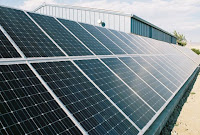 A majority of the electric power we are consuming daily comes from power plants using coal and oil to generate electricity. Do you know that we can actually replace these dirty energy sources with more green and nature-friendly alternatives such as solar power? Here are tips for you to start to do your very own GREEN panel.
A majority of the electric power we are consuming daily comes from power plants using coal and oil to generate electricity. Do you know that we can actually replace these dirty energy sources with more green and nature-friendly alternatives such as solar power? Here are tips for you to start to do your very own GREEN panel.A solar panel consists of the following fundamental components, such as the photovoltaic cells, holding frame, plastic or glass cover and wires.
The key factor to build your own solar panel is to get a workable photovoltaic cell for your project, in term of price and user-friendliness. You might get a compact lightweight 3.6V 70mA solar cells made with a thin film of Copper Indium di Selenide (CIS) to build your own panel.
Buy a tabbed CIS cells which already had the two little pieces of wire soldered onto them. These tabs makes building solar panels much faster because you can jump right in and string the cells together. The number of cells you need to build your solar panel will depends on how much voltage you need to charge. You could easily to find a source to purchase by Google it.
Next will be just the action steps to put stuff together to make your solar panel works.
Connecting these cells together in series, with the negative side to the positive side of the adjacent cell through the tabs on the side of each photo cell, to accumulate total voltage charges you required. Soldering these cells together, then attach it to the holding frame with glue. Cover these photo cells once you have done the wiring with glass or plastic cover.
The use of solar energy is not yet prevalent enough to find everyone using it but there are a few people that feel they can help the environment with the use of solar power. With the cost of electricity on the rise and the economy spiraling downward, more people are interested in saving on their utility bills or totally eliminating them with the use of solar power. Home solar power systems are great alternative power generating systems that can help you save money and do its part in saving the planet. There is much talk about global warming and the greenhouse effect and the use of solar power, as an alternative power source, can make us feel good about ourselves as we do our part.
Useful information generate electricity:
http://ezinearticles.com/?Learn-How-to-Generate-Electricity-With-a-Magnetic-Generator&id=3380374
Learn how to build your own solar panel:
http://ezinearticles.com/?How-to-Build-Your-Own-Solar-Panel-to-Save-Electricity-in-Your-Home&id=2435153
Learn how to building solar panel:
http://ezinearticles.com/?Building-Solar-Panels-From-the-Comfort-of-Home&id=3717430


















